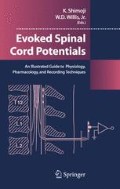Abstract
Using a microelectrode, it is a straightforward procedure to record the responses of single neurons within the spinal cord gray matter to stimulation of primary afferents (Willis and Coggeshall, 2004). Interneurons in the dorsal horn can be distinguished from afferent axons by their response properties and by the configuration of their action potentials. For example, interneurons can generally be activated by a number of different types of sensory receptors, whereas a primary afferent fiber would belong to just a single kind of sense organ. The extracellular action potentials of interneurons are predominantly negative (Fig. 2.1A), whereas those of afferent axons are chiefly positive in sign (because they are usually recorded just outside an internode and only rarely outside a node of Ranvier). Intracellular recordings from dorsal horn interneurons reveal postsynaptic potentials in response to stimulation of primary afferent fibers (Fig. 2.1B, upper trace). In the ventral horn, a motor neuron can be identified by antidromic activation following stimulation of its motor axon.
Access this chapter
Tax calculation will be finalised at checkout
Purchases are for personal use only
Preview
Unable to display preview. Download preview PDF.
Section A: Chapter 2
Alvarez-Leefmans FJ, Leon-Olea M, Mendoza-Sotelo J, Alvarez FJ, Anton B, Garduno R. Immunolocalization of the Na(+)-K(+)-2Cl(−) cotransporter in peripheral nervous tissue of vertebrates. Neuroscience 2001;104(2):569–82.
Andrew D, Craig AD. Spinothalamic lamina I neurones selectively responsive to cutaneous warming in cats. J Physiol 2001;537:489–95.
Apkarian AV, Hodge CJ. Primate spinothalamic pathways. I. A quantitative study of the cells of origin of the spinothalamic pathway. J Comp Neurol 1989;288:447–73.
Beall JE, Applebaum AE, Foreman RD, Willis WD. Spinal cord potentials evoked by cutaneous afferents in the monkey. J Neurophysiol 1977;40:199–211.
Chung JM, Kenshalo DR, Gerhart KD, Willis WD. Excitation of primate spinothalamic neurons by cutaneous C-fiber volleys. J Neurophysiol 1979;42:1354–69.
Craig AD, Krout K, Andrew D. Quantitative response characteristics of thermoreceptive and nociceptive lamina I spinothalamic neurons in the cat. J Neurophysiol 2001;86:1459–80.
Dostrovsky JO, Craig AD. Cooling specific spinothalamic neurons in the monkey. J Neurophysiol 1996;76:3656–65.
Dougherty PM, Sluka KA, Sorkin LS, Westlund KN, Willis WD. Neural changes in acute arthritis in monkeys: I. Parallel enhancement of responses of spinothalamic tract neurons to mechanical stimulation and excitatory amino acids. Brain Res Rev 1992;17:1–13.
Eccles JC. The physiology of synapses. New York: Springer; 1964.
Eccles JC, Kostyuk PG, Schmidt RF. Central pathways responsible for depolarization of primary afferent fibres. J Physiol 1962;161:237–57.
Eccles JC, Schmidt RF, Willis WD. Pharmacological studies on presynaptic inhibition. J Physiol 1963a;168:500–30.
Eccles JC, Schmidt RF, Willis WD. The location and the mode of action of the presynaptic inhibitory pathways on to group Ia afferent fibers from muscle. J Neurophysiol 1963b;26:506–22.
Ferrington DG, Sorkin LS, Willis WD. Responses of spinothalamic tract cells in the superficial dorsal horn of the primate lumbar spinal cord. J Physiol 1987;388:681–703.
Foreman RD, Schmidt RF, Willis WD. Effects of mechanical and chemical stimulation of fine muscle afferents upon primate spinothalamic tract cells. J Physiol 1979;286:215–31.
Foreman RD, Blair RW, Weber RN. Viscerosomatic convergence onto T2–T4 spinoreticular, spinoreticular-spinothalamic, and spinothalamic tract neurons in the cat. Exp Neurol 1984;85:597–619.
Giesler GJ, Yezierski RP, Gerhart KD, Willis WD. Spinothalamic tract neurons that project to medial and/or lateral thalamic nuclei: Evidence for a physiological novel population of spinal cord neurons. J Neurophysiol 1981;46:1285–308.
Maixner W, Dubner R, Bushnell MC, Kenshalo DR, Oliveras JL. Wide-dynamic-range dorsal horn neurons participate in the encoding process by which monkeys perceive the intensity of noxious heat stimuli. Brain Res 1986;374:385–8.
Mendell LM. Physiological properties of unmyelinated fiber projections to the spinal cord. Exp Neurol 1966;16:316–32.
Milne RJ, Foreman RD, Giesler GJ, Willis WD. Convergence of cutaneous and pelvic visceral nociceptive input onto primate spinothalamic neurons. Pain 1981;11:163–83.
Owens CM, Zhang D, Willis WD. Changes in the response states of primate spinothalamic tract cells caused by mechanical damage of the skin or activation of descending controls. J Neurophysiol 1992;67:1509–27.
Surmeier DJ, Honda CN, Willis WD. Responses of primate spinothalamic neurons to noxious thermal stimulation of glabrous and hairy skin. J Neurophysiol 1986;56:328–50.
Willis WD. Evoked spinal cord potentials in the cat and monkey: use in the analysis of spinal cord function. In: Homma S, Tamaki T, editors; Shimoji K, Kurokawa T, co-editors. Fundamentals and clinical application of spinal cord monitoring. Tokyo: Saikon; 1984. p. 3–19.
Willis WD. Neural mechanisms of pain discrimination. In: Lund JS, editor. Sensory processing in the mammalian brain. Oxford: Oxford University Press; 1989. p. 130–43.
Willis WD. Dorsal root potentials and dorsal root reflexes: a double-edged sword. Exp Brain Res 1999;124:395–421.
Willis WD, Coggeshall RE. Sensory mechanisms of the spinal cord. 3rd ed. New York: Kluwer Academic/Plenum; 2004.
Willis WD, Trevino DL, Coulter JD, Maunz RA. Responses of primate spinothalamic tract neurons to natural stimulation of hindlimb. J Neurophysiol 1974;37:358–72.
Willis WD, Kenshalo DR, Leonard RB. The cells of origin of the primate spinothalamic tract. J Comp Neurol 1979;188:543–74.
Willis WD, Zhang X, Honda CN, Giesler GJ. Projections from the marginal zone and deep dorsal horn to the ventrobasal nuclei of the primate thalamus. Pain 2001;92:267–76.
Zhang D, Owens CM, Willis WD. Short-latency excitatory postsynaptic potentials are evoked in primate spinothalamic tract neurons by corticospinal tract volleys. Pain 1991;45:197–201.
Editor information
Editors and Affiliations
Rights and permissions
Copyright information
© 2006 Springer-Verlag Tokyo
About this chapter
Cite this chapter
Willis, W.D. (2006). Physiology of the Spinal Cord. In: Shimoji, K., Willis, W.D. (eds) Evoked Spinal Cord Potentials. Springer, Tokyo. https://doi.org/10.1007/4-431-30901-2_2
Download citation
DOI: https://doi.org/10.1007/4-431-30901-2_2
Publisher Name: Springer, Tokyo
Print ISBN: 978-4-431-24026-6
Online ISBN: 978-4-431-30901-7
eBook Packages: MedicineMedicine (R0)

